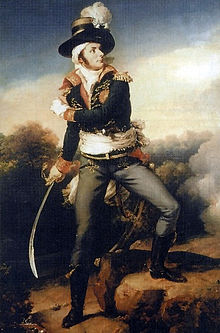François Athanase de Charette de la Contrie
François Athanase de Charette de la Contrie (born April 21, 1763 in Couffé , Loire-Atlantique department ; † executed on February 29, 1796 in Nantes ) was a French naval officer and one of the leaders of the Armée catholique et royale de Vendée during the uprising there in the years 1793 to 1796.
Life
François de Charette came from a family of the French landed nobility in the Vendée department , a region in western France. After training at a naval school, which began in 1779, he served as an officer under Toussaint-Guillaume Picquet de la Motte and Luc Urbain du Bouëxic de Guichen and took part in the American War of Independence . When the French Revolution broke out in 1789, Charette resigned from the army. For only a short time he emigrated to Koblenz and after his return to France took part in the defense of Louis XVI. and his family during the storm on the Tuileries on August 10, 1792.
According to his biographers, when the uprising in the Vendée broke out in the spring of 1793, the farmers of his homeland urged him to take over their leadership. On March 10, 1793 - one week after the start of the uprising - the troops led by him succeeded in retaking the village of Machecoul , with which Charette controlled the entire Pays de Retz , a region south of the mouth of the Loire . Until the failed attempt to conquer Nantes at the end of June 1793, Charette played a rather subordinate role and so, after Cathelineau's death on July 14, 1793, d'Elbée was given supreme command of the royalist Catholic troops instead.
After the temporary suppression of the uprising in December 1793 and the end of the great battles between royalists and republicans, he began a guerrilla fight, in which he achieved a major military victory in 1794 with the capture of a republican camp near Saint-Christophe near Challans .
On February 17, 1795 he finally signed a peace treaty together with emissaries from the National Convention in Jaunaye Castle, near Vertou , which he kept for only five months. On the promise of the English to support him with a landing operation, he took up arms again on July 23, 1795 and was killed on February 22, 1796 - after he was killed by Louis XVIII. was appointed commander of the royalist troops - captured and executed seven days later in Nantes .
literature
- Article “Charette”, in: Jean Tulard / Jean-François Fayard / Alfred Fierro: Histoire et dictionnaire de la Révolution française: 1789–1799 , 2nd reprint, Paris 1988, ISBN 2-221-04588-2 , p. 639
- Michel de Saint Pierre: Monsieur de Charette, chevalier du roi , Paris 1982, ISBN 2-07-037409-2
Web links
| personal data | |
|---|---|
| SURNAME | Charette de la Contrie, François Athanase de |
| ALTERNATIVE NAMES | Charette, François de |
| BRIEF DESCRIPTION | French naval officer and one of the leaders of the Vendée uprising |
| DATE OF BIRTH | April 21, 1763 |
| PLACE OF BIRTH | Couffé |
| DATE OF DEATH | February 29, 1796 |
| Place of death | Nantes |
